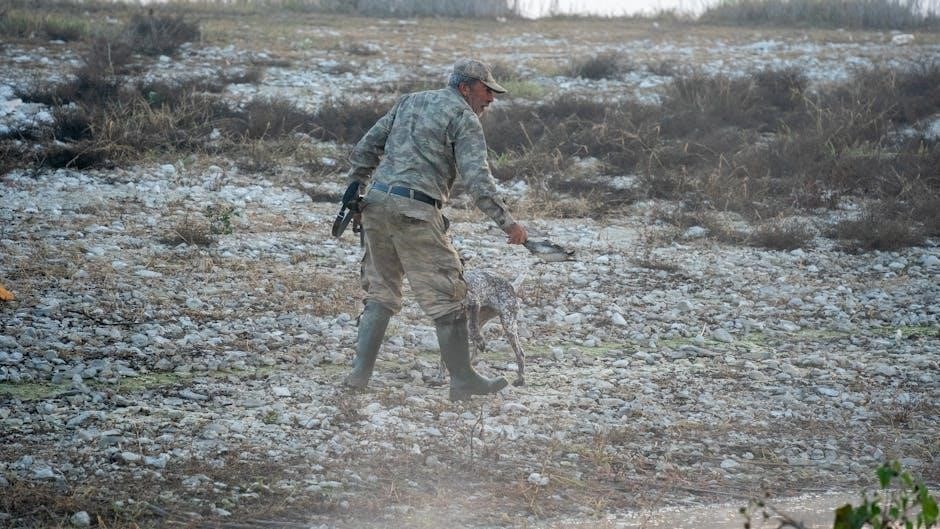The 2024 Terrain Characterization Guide provides updated methodologies and standards for assessing and managing contaminated sites in Quebec, ensuring compliance with environmental regulations.
1.1 Overview of the Guide’s Purpose and Scope
The 2024 Terrain Characterization Guide aims to provide a comprehensive framework for assessing and managing contaminated sites in Quebec. It outlines the purpose and scope of terrain characterization, ensuring compliance with environmental regulations and standards. The guide covers key methodologies for soil, groundwater, and site evaluations, aligning with the Canadian Standards Association (CSA) and Quebec’s Environmental Protection Act. It serves as a reference for professionals, detailing requirements for site investigations and remediation strategies to ensure effective and uniform practices across the province.
1.2 Key Updates and Improvements in the 2024 Edition
The 2024 edition introduces enhanced methodologies for soil and groundwater characterization, incorporating recent advancements in environmental science. It includes updated compliance standards with CSA Z768-01 and aligns with Quebec’s Environmental Protection Act. New sections emphasize risk assessment and management strategies, ensuring a more robust approach to site remediation. The guide also provides clearer guidelines for Phase I, II, and III assessments, offering practitioners a streamlined framework for effective terrain characterization and rehabilitation practices. These updates aim to improve accuracy and efficiency in site evaluations.


Key Methodologies and Approaches
This section outlines advanced methodologies for soil and groundwater assessment, integrating physical-chemical analysis and geotechnical evaluations to ensure comprehensive site characterization and effective environmental management strategies.
2.1 Physical-Chemical Characterization of Soils
This section provides detailed protocols for analyzing soil properties, including texture, organic matter content, and contaminant levels. Advanced laboratory techniques are outlined to ensure accurate identification of soil composition and potential pollutants. The guide emphasizes the importance of standardized sampling methods to maintain data consistency and reliability. By integrating physical and chemical analyses, practitioners can assess soil health and determine appropriate remediation strategies. These procedures align with Quebec’s environmental regulations and promote sustainable land management practices.
2.2 Geotechnical and Environmental Site Assessments
This section outlines procedures for conducting comprehensive site assessments, integrating both geotechnical and environmental evaluations. It covers the analysis of soil stability, groundwater flow, and contaminant migration. The guide emphasizes the importance of site-specific investigations to identify potential risks and ensure compliance with regulatory standards. By combining these assessments, practitioners can develop a holistic understanding of site conditions, enabling effective decision-making for remediation or development projects while safeguarding environmental and structural integrity.
2.3 Sampling Strategies and Analytical Procedures
This section outlines standardized methods for collecting and analyzing soil, water, and air samples to ensure accurate and reliable data. It emphasizes systematic approaches to sampling, including spatial distribution and depth considerations, to capture representative conditions. The guide aligns with regulatory standards, such as CSA Z768-01, and incorporates advanced technologies like GIS mapping and statistical models for data interpretation. Quality control measures are highlighted to ensure the integrity of results, supporting robust decision-making for site characterization and remediation efforts.

Legal and Regulatory Framework
The 2024 Guide aligns with Quebec’s Environmental Protection Act (LQE) and Canadian standards like CSA Z768-01, ensuring compliance in site characterization and contaminated land management.
3.1 Quebec’s Environmental Protection Act (LQE)
Quebec’s Environmental Protection Act (LQE) establishes the legal framework for managing contaminated sites, requiring detailed characterization and remediation. Section IV of Chapter IV, Title I, specifically addresses contaminated land, mandating studies to assess soil, groundwater, and other media. The 2024 Guide aligns with these provisions, ensuring compliance through standardized methodologies. It emphasizes the importance of risk assessment and rehabilitation strategies to protect human health and the environment. By adhering to LQE, the Guide promotes sustainable land management and environmental stewardship in Quebec.
3.2 Compliance with Canadian Standards (CSA Z768-01)
The 2024 Guide adheres to Canadian Standards Association (CSA) Z768-01, ensuring environmental site assessments (ESAs) are conducted systematically. This standard outlines procedures for Phase I and Phase II assessments, emphasizing site history, property use, and neighboring land evaluations. Compliance with CSA Z768-01 guarantees thorough identification of potential contaminants, aligning with national best practices. The Guide integrates these standards to ensure comprehensive site characterization, facilitating effective risk management and remediation strategies while maintaining regulatory consistency across Canada.

Environmental Site Assessment Phases
The 2024 Guide outlines three phases for environmental site assessments, providing a structured approach to site evaluation, from initial screening to detailed investigations and remediation planning.

4.1 Phase I: Preliminary Site Evaluation
Phase I involves identifying potential contamination sources and evaluating historical site uses. It includes reviewing documents, interviews, and site visits to assess contamination risks. Key activities focus on identifying environmental concerns, such as hazardous substance use or waste disposal. The goal is to determine if further investigation is needed. This phase ensures early detection of potential issues, guiding decisions on whether to proceed to Phase II. It is a critical step in managing environmental liabilities and ensuring compliance with regulatory requirements.
4.2 Phase II: Detailed Site Investigation
Phase II involves detailed site investigation to confirm and characterize contamination detected during Phase I. It includes soil and groundwater sampling, laboratory analysis, and mapping the extent of contamination. This phase provides a comprehensive understanding of the site’s conditions, guiding remediation strategies and ensuring compliance with environmental laws and standards such as CSA Z768-01.
4.3 Phase III: Remediation and Risk Management
Phase III focuses on remediation and risk management, addressing contamination identified in earlier phases; It involves implementing targeted cleanup strategies, such as soil rehabilitation and groundwater treatment, to restore the site to safe conditions. Risk management plans are developed to mitigate long-term environmental impacts, ensuring compliance with regulations like the LQE and CSA standards. This phase also includes monitoring and verification to confirm the effectiveness of remediation efforts, providing a clear path for site reuse and environmental sustainability.
Characterization of Contaminated Sites
This section outlines the systematic approach to identifying contaminants and their extent in contaminated sites, utilizing advanced analytical techniques and site assessments to determine environmental risks.
5.1 Identifying Contaminants and Their Extent
This section details the process of detecting and delineating contaminants in soil, groundwater, and other media. It emphasizes the use of sampling strategies, laboratory analysis, and geospatial mapping to determine the full extent of contamination. Advanced methodologies ensure accurate identification of contaminant types and concentrations, aligning with regulatory standards like CSA Z768-01. The guide also highlights the importance of integrating historical site data and environmental assessments to inform comprehensive contamination profiles, ensuring effective risk management and remediation planning.
5.2 Risk Assessment and Management Strategies
This section outlines a systematic approach to evaluating contaminant risks to human health and the environment. It integrates site-specific data, toxicity thresholds, and exposure pathways to prioritize risks. The guide emphasizes compliance with regulatory standards and the development of tailored management plans. Strategies include containment, monitoring, and remediation, ensuring long-term environmental and public health protection. Adaptive management frameworks are also highlighted to address evolving site conditions and stakeholder concerns effectively.
Rehabilitation and Remediation Strategies
This section outlines effective methods for soil and groundwater remediation, focusing on sustainable techniques to restore contaminated sites to safe conditions while complying with environmental regulations.
6.1 Soil Rehabilitation Techniques
The 2024 Guide details advanced soil rehabilitation methods, including bioremediation, phytoremediation, and thermal treatment. These techniques aim to degrade or remove contaminants, restoring soil health for safe reuse. Compliance with Quebec’s environmental standards ensures effectiveness and sustainability, addressing both organic and inorganic pollutants efficiently.
6.2 Groundwater Remediation Methods
The 2024 Guide outlines effective groundwater remediation techniques, including pump-and-treat systems, in-situ chemical oxidation, and bioremediation. These methods target contaminant removal or degradation, ensuring water quality meets regulatory standards. Advanced technologies, such as permeable reactive barriers, are also highlighted for long-term solutions. The guide emphasizes sustainable approaches to restore aquifers safely and efficiently, aligning with Quebec’s environmental protection goals.

Case Studies and Practical Applications
The 2024 Guide includes case studies demonstrating successful site characterization and remediation in Quebec, showcasing practical applications of updated methodologies and technologies for environmental compliance and sustainability.
7.1 Successful Site Characterization Projects in Quebec
The 2024 Guide highlights several successful site characterization projects in Quebec, demonstrating effective application of updated methodologies. These case studies illustrate how advanced sampling strategies and analytical techniques were employed to identify contaminants and assess their extent. Projects include soil and groundwater remediation efforts in industrial and urban areas, showcasing compliance with CSA Z768-01 standards. These examples emphasize the importance of integrated approaches, ensuring accurate site assessments and sustainable land reuse, while aligning with Quebec’s environmental regulations and promoting best practices in terrain characterization.
7.2 Lessons Learned from Recent Case Studies
Recent case studies outlined in the 2024 Guide reveal key lessons for improving terrain characterization practices. These include the importance of early contaminant identification, precise sampling strategies, and collaboration between stakeholders. Challenges such as data interpretation variability and regulatory compliance were addressed through adaptive methodologies. The studies underscore the value of integrating advanced technologies and adhering to updated standards, ensuring more accurate assessments and effective remediation strategies. These insights contribute to refining future practices and enhancing the efficiency of environmental site assessments in Quebec.

Tools and Resources for Effective Characterization
The 2024 Guide provides a comprehensive suite of tools, including detailed PDF manuals and advanced digital software, to ensure precise terrain assessments and informed decision-making processes.
8.1 Guides and Manuals for Practitioners
The 2024 Guide provides comprehensive manuals for practitioners, including detailed PDF resources and updated methodologies. These documents outline standardized procedures for soil and groundwater characterization, ensuring compliance with Quebec’s environmental regulations. The guides cover sampling strategies, analytical methods, and risk assessment frameworks, offering practical tools for professionals. They also include revised sections on contaminated site rehabilitation and alignment with Canadian standards like CSA Z768-01. These resources are essential for ensuring accurate and efficient terrain characterization processes.
8.2 Digital Tools and Software for Data Analysis
The 2024 Guide highlights advanced digital tools and software for efficient data analysis in terrain characterization. These tools facilitate comprehensive assessment of soil, groundwater, and environmental data, enabling precise risk evaluations. Specialized software supports detailed mapping, contamination tracking, and compliance reporting. By integrating these technologies, practitioners can streamline processes, enhance accuracy, and ensure adherence to regulatory standards. These tools are integral to modern site characterization, offering innovative solutions for environmental management and sustainable practices.